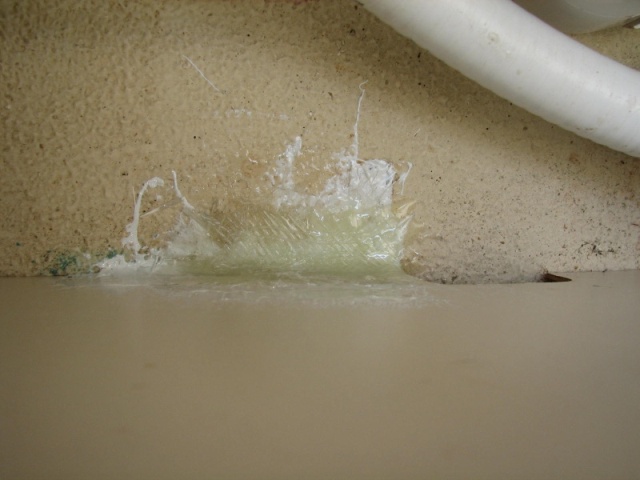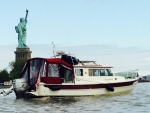| View previous topic :: View next topic |
| Author |
Message |
Doryman
Joined: 03 Oct 2006
Posts: 3807
City/Region: Anacortes
State or Province: WA
C-Dory Year: 2006
C-Dory Model: 255 Tomcat
Vessel Name: Lori Ann
Photos: Lori Ann
|
 Posted: Sun Sep 02, 2007 11:50 am Post subject: Glass tabbing Posted: Sun Sep 02, 2007 11:50 am Post subject: Glass tabbing |
 |
|
| thataway wrote: | I see the ferrous brackets into the hull of the CD 25 as a problem, and all of these have been removed in mine (DIY--simple to do with glass tabbing the way it should have been done at first).
In the Tom Cat, there are no brackets screwed into the hull, they are screwed into a cored floor. This does not produce the risk which screwing into the hull gives, since there should be no water standing on the floor or water intrusion into the core of the floor. But it would be best to remove these and do tabbing instead in the long run. It probably will quiet the boat some also. |
I'm breaking this thread off from the "My oberservations after my first ride on a C-25 and Tomcat" discussion.
To me, the implication of using a tab means basically a right-angle "piece" of fiberglass through which a screw would be inserted.
Am I correct in understanding that, in this context, you are basically glassing the bulkhead or cabinet member to the hull?
Thanks,
Warren
_________________
Doryman
M/V Lori Ann
TomCat 255, Hull #55, 150 Yamahas
Anacortes, WA
 |
|
| Back to top |
|
 |
thataway
Joined: 02 Nov 2003
Posts: 21497
City/Region: Pensacola
State or Province: FL
C-Dory Year: 2007
C-Dory Model: 25 Cruiser
Vessel Name: thataway
Photos: Thataway
|
 Posted: Sun Sep 02, 2007 11:17 pm Post subject: Posted: Sun Sep 02, 2007 11:17 pm Post subject: |
 |
|
I have had several inquiries about this. The issue is certainly present in at least some of the CD 25's. I cannot comment about the newer CD 22's. If there are screws into the bottom of the hull, they need to be addressed; in some cases just a sealant may be adequate, but in others they need to be drilled out, cored with epoxy, or tabbed with fiberglass.
The screws are removed from the "L" Bracket. The screw holes are drilled out slightly and a thickened epoxy (with cabosil or high density filler) is worked down into the hole, with a splinter of wood. The epoxy is smoothed off the surface.
I cut two 3" x 3" pieces of glass--it can be 6 oz cloth or 12 oz biaxial cloth, which is compatable with epoxy. The bottom (top of the hull surface) of the cabinate is ground smooth with a sander or grinder just so the gel coat is cut thru and the glass is showing--not into the glass. The Decaboard is roughed up slightly
The pieces of glass are laid 1 1/2" up on the Decaboard and 1 1/2" down on the bottom, after a coating of epoxy is laid on the Decaboard and hull. I also put a Filet along the junction of the decaboard and the bottom. Most hulls have bulkheads and cabinets which are tabbed into the hull bottom or sides with glass which goes the entire length of the bulkhead's contact area with the hull. This is not necessary in the C Dories.
I put 3 layers of 6 oz cloth or two layers of 12oz biaxial. Both are far stronger than the screws and "L" bracket. There is no possibility of water intrusion into the hull. I have seen some pictures and discriptions of water intrusion into the hull, and some bulkheads. This must be repaired if it occurs, and should be prevented by the removal of the "L" brackets and the screws.
The Tom Cat 255 is a different story. The screws and "L" brackets are not into the hull of the boat, they are into an interior deck laminate. There is little if any chance of water standing there. I have not yet removed the "L" brackets of the TC 255. I may after putting in the auxillary water tank.

The above is looking straight down on a tab which has replaced one of the "L" brackets of the "step" in the aft cabin floor of the CD 25.
_________________
Bob Austin
Thataway
Thataway (Ex Seaweed) 2007 25 C Dory May 2018 to Oct. 2021
Thisaway 2006 22' CDory November 2011 to May 2018
Caracal 18 140 Suzuki 2007 to present
Thataway TomCat 255 150 Suzukis June 2006 thru August 2011
C Pelican; 1992, 22 Cruiser, 2002 thru 2006
Frequent Sea; 2003 C D 25, 2007 thru 2009
KA6PKB
Home port: Pensacola FL |
|
| Back to top |
|
 |
Pat Anderson
Joined: 02 Nov 2003
Posts: 8556
City/Region: Birch Bay, WA
State or Province: WA
C-Dory Year: 2005
C-Dory Model: 25 Cruiser
Vessel Name: Daydream
Photos: Daydream and Crabby Lou
|
 Posted: Mon Sep 03, 2007 10:34 am Post subject: Posted: Mon Sep 03, 2007 10:34 am Post subject: |
 |
|
Thanks, Bob! As usual, a clear and useful explanation! We will take a look at doing this!
_________________
DAYDREAM - CD25 Cruiser
CRABBY LOU - CD16 Angler (sold 2020)
Pat & Patty Anderson, C-Brat #62!
http://daydreamsloop.blogspot.com

|
|
| Back to top |
|
 |
westward
Joined: 18 Feb 2005
Posts: 718
City/Region: Seattle
State or Province: WA
C-Dory Year: 1985
C-Dory Model: 16 Angler
Vessel Name: TBD
Photos: Steady Eddy
|
 Posted: Mon Sep 03, 2007 11:51 am Post subject: Posted: Mon Sep 03, 2007 11:51 am Post subject: |
 |
|
| I also thank you for the info. The cabinetry assemblage in our new 22' Angler is attached to the hull via L-brackets and screws straight down into the hull. Although this is all within the interior, I'm really not thrilled about unsealed screws into the hull of a water moored, balsa cored vessel. I also suspect that a more permanent bond would quiet things down and possibly impart strength by unitizing things. In the interest of simplicity, however, I was planning to use a continuous bead of 5200 rather than attempting glass work. I would probably leave a few gaps for drainage, or perhaps drill/seal drain holes in a few places, mainly to facilitate me misting out the cavities during Fall cleanup. My second, probably bigger concern is how to stiffen the cockpit gunnels in the vertical interior plane, where the plastic storage insert is installed. On our old cruiser I believe this storage area was factory fabricated and bonded to the side of the hull, including a continuous bottom shelf, and was quite sturdy. Now it's a pre-made plastic insert screwed into a flimsy cutout with smallish chunks of untreated plywood at either end for backing. When you lean against the gunnel, such as when retrieving a crab pot, netting a fish, handling lines, etc., the entire thing flexes very easily. This can't be good in the long run. We also like a small cleat on this surface for fender attachment, and I sure don't want that type of stress on a flexing surface. I'm running some fixes through my head, and will report my progress/photos as I proceed. I also welcome any suggestions others may have. Somewhat bewildering to talk of reinforcing a working surface on a brand-new, fairly expensive boat, but I'm pretty happy with the boat overall. All the best, Mike. |
|
| Back to top |
|
 |
thataway
Joined: 02 Nov 2003
Posts: 21497
City/Region: Pensacola
State or Province: FL
C-Dory Year: 2007
C-Dory Model: 25 Cruiser
Vessel Name: thataway
Photos: Thataway
|
 Posted: Mon Sep 03, 2007 6:49 pm Post subject: Posted: Mon Sep 03, 2007 6:49 pm Post subject: |
 |
|
Mike,
A photo of the area under the gunnel would help. I think I visualize this--and it was open in our 1992 CD 22 as well as in the 2003 CD 25. The Tom Cat 25 has the plastic "storage areas"--but the side walls of the cockpit are substantial fiberglass. What you describe does not sound good.
I feel that tabbing is better than attempting to "glue" with the 5200. At times 5200 adheres very well, rarely it does not. One of the places where I have seen it not work well is to try and glue plywood shelves (end grain) to the side of a boat..
Thanks for the comments. |
|
| Back to top |
|
 |
|
|
You cannot post new topics in this forum
You cannot reply to topics in this forum
You cannot edit your posts in this forum
You cannot delete your posts in this forum
You cannot vote in polls in this forum
You cannot attach files in this forum
You cannot download files in this forum
|
|

 Search
Search Private Messages
Private Messages Profile
Profile Log in
Log in Register
Register Help
Help



